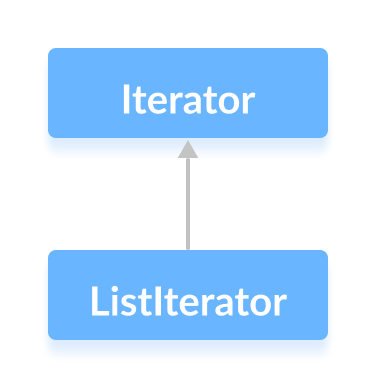ListIterator接口的Java集合框架提供了访问list元素的功能。
它是双向的。这意味着它允许我们沿着两个方向遍历列表的元素。
它扩展了Iterator接口。

List接口提供了一个listIterator()方法,该方法返回ListIterator接口的实例。
ListIterator的方法
ListIterator接口提供了可用于对列表元素执行各种操作的方法。
hasNext()- 如果列表中存在元素,则返回truenext()- 返回列表的下一个元素nextIndex()返回next()方法将返回的元素的索引previous()- 返回列表的先前元素previousIndex()- 返回previous()方法将返回的元素的索引remove()- 删除由next()或previous()返回的元素set()- 用指定元素替换由next()或previous()返回的元素
示例1:ListIterator的实现
在下面的示例中,我们在array list中实现了ListIterator接口的next()、nextIndex()和hasNext()方法。
import java.util.ArrayList;
import java.util.ListIterator;
class Main {
public static void main(String[] args) {
// Creating an ArrayList
ArrayList<Integer> numbers = new ArrayList<>();
numbers.add(1);
numbers.add(3);
numbers.add(2);
System.out.println("ArrayList: " + numbers);
// Creating an instance of ListIterator
ListIterator<Integer> iterate = numbers.listIterator();
// Using the next() method
int number1 = iterate.next();
System.out.println("Next Element: " + number1);
// Using the nextIndex()
int index1 = iterate.nextIndex();
System.out.println("Position of Next Element: " + index1);
// Using the hasNext() method
System.out.println("Is there any next element? " + iterate.hasNext());
}
}
输出
ArrayList: [1, 3, 2] Next Element: 1 Position of Next Element: 1 Is there any next element? true
示例2:ListIterator的实现
在下面的示例中,我们在array list中实现了ListIterator接口的previous()和previousIndex()方法。
import java.util.ArrayList;
import java.util.ListIterator;
class Main {
public static void main(String[] args) {
// Creating an ArrayList
ArrayList<Integer> numbers = new ArrayList<>();
numbers.add(1);
numbers.add(3);
numbers.add(2);
System.out.println("ArrayList: " + numbers);
// Creating an instance of ListIterator
ListIterator<Integer> iterate = numbers.listIterator();
iterate.next();
iterate.next();
// Using the previous() method
int number1 = iterate.previous();
System.out.println("Previous Element: " + number1);
// Using the previousIndex()
int index1 = iterate.previousIndex();
System.out.println("Position of the Previous element: " + index1);
}
}
输出
ArrayList: [1, 3, 2] Previous Element: 3 Position of the Previous Element: 0
在上面的示例中,最初,Iterator的实例在1之前。由于1之前没有元素,调用previous()方法将抛出异常。
然后我们使用了2次的next()方法。现在Iterator的实例将在3和2之间。
因此,previous()方法返回3。